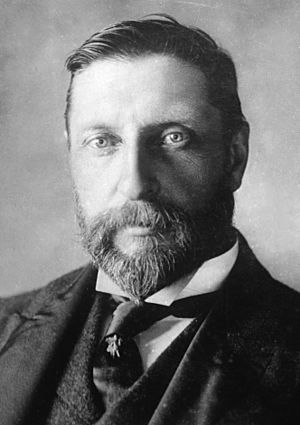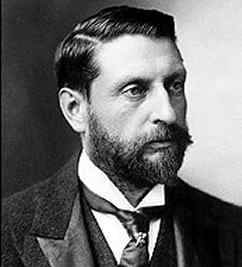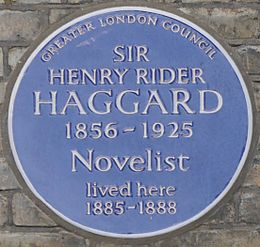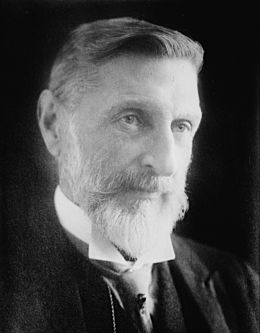H. Rider Haggard facts for kids
Quick facts for kids
H. Rider Haggard
|
|
|---|---|
 |
|
| Born | Henry Rider Haggard 22 June 1856 Bradenham, Norfolk, England |
| Died | 14 May 1925 (aged 68) Marylebone, London, England |
| Resting place | St. Mary's Church, Ditchingham, Norfolk, England |
| Occupation | Novelist, scholar |
| Nationality | British |
| Period | 19th & 20th century |
| Genre | Adventure, fantasy, fables, romance, sci-fi, historical |
| Subject | Africa |
| Notable works | King Solomon's Mines, Allan Quatermain series, She: A History of Adventure |
| Signature | |
 |
|
Sir Henry Rider Haggard (born June 22, 1856 – died May 14, 1925) was a famous English writer. He is best known for his exciting adventure stories, many of which take place in Africa. He helped create the "lost world" type of story, where characters discover hidden places and ancient civilizations. His books are still popular today and have inspired many other writers and movies.
Contents
Life and Career
Early Life and Education
Henry Rider Haggard was born in Bradenham, England. He was one of ten children. His father was a lawyer, and his mother was a writer and poet.
Unlike his older brothers, Henry did not go to expensive private schools. He attended Ipswich Grammar School. His father thought he might not achieve much, so he couldn't afford a costly education for him.
After school, Henry tried to join the army but didn't pass the test. He then studied in London for a different exam, but he never took it. During this time, he met people who were interested in unusual studies, like how the mind works.
Time in South Africa (1875–1882)
In 1875, when he was 19, Henry's father sent him to South Africa. He worked for the government there, helping important officials. In 1877, he was part of a big event in Pretoria. He even helped raise the British flag when the Transvaal region became part of the British Empire.
While in Africa, Henry fell in love with a woman named Lilly Jackson. He wanted to marry her, but his father said no until he had a stable job. Lilly later married someone else.
In 1880, Henry returned to England and married Marianna Louisa Margitson. They went back to Africa together. They had four children: a son named Jack, who sadly died young, and three daughters, Angela, Dorothy, and Lilias. His daughter Lilias later became a writer, just like her father.
Life in England (1882–1925)
Henry and his wife moved back to England in 1882 and settled in Norfolk. Henry studied law and became a lawyer, but he spent most of his time writing novels. He found writing much more rewarding.
He wrote his famous book, King Solomon's Mines, in London in 1885. Many of his adventure stories were inspired by the brave explorers and discoveries he heard about in Africa. He learned about the rich minerals and ancient ruins found there, like Great Zimbabwe.
Years later, Henry helped his old friend Lilly Jackson. Her husband had left her and her sons. Henry provided a house for them and made sure her children got an education. He continued to support Lilly until she passed away.
Writing Career
After returning to England, Henry wrote a few books that weren't very successful. Then, he wrote King Solomon's Mines, which became a huge hit! He chose to get a small percentage of the book's sales instead of a one-time payment, which turned out to be a very smart decision.
He wrote many other popular adventure novels, including Allan Quatermain and the famous She. She sold over 83 million copies by 1965, making it one of the best-selling books ever! He also wrote Nada the Lily, about the Zulu people, and Eric Brighteyes, an epic Viking story.
Haggard's books often showed a lot of understanding for the native people, even though the main characters were usually European. For example, in King Solomon's Mines, the Zulu warrior Umslopogaas and King Ignosi are brave heroes.
Henry also wrote about farming and social improvements, inspired by his time in Africa and what he saw in Europe. He was good friends with the famous writer Rudyard Kipling. They shared many ideas and remained friends throughout their lives.
Public Service
Haggard was very involved in improving farming and land use. He was part of many groups that studied these issues, which meant he traveled a lot to different parts of the British Empire. His work helped create new laws to improve land use.
He also tried to become a member of Parliament in 1895 but didn't win. He was honored by the King twice for his work, first in 1912 and again in 1919.
Death
Henry Rider Haggard passed away on May 14, 1925, in London, at the age of 68. His ashes were buried in a church in Ditchingham.
Legacy
Influence on Other Writers
Henry Rider Haggard's stories had a big impact on many other writers. The famous psychologist Carl Jung even studied the character Ayesha from She. His "lost world" stories inspired popular American writers like Edgar Rice Burroughs (who created Tarzan) and Robert E. Howard (who created Conan the Barbarian).
The adventure hero Allan Quatermain from King Solomon's Mines was a model for the character Indiana Jones in the movies! Quatermain has also become popular again as a main character in the League of Extraordinary Gentlemen comics and movies.
The writer Graham Greene said that Haggard's stories "fixed pictures in our minds that thirty years have been unable to wear away." He is seen as one of the most important storytellers of his time.
Views on Race
Some people have criticized Rider Haggard's books for how they describe non-European characters. For example, the Kenyan author Ngũgĩ wa Thiong'o said that some of Haggard's descriptions of African people were not fair. It's important to remember that books from the past sometimes show ideas that we now know are not right or respectful.
Influence on Children's Literature
Haggard's books were very popular with young readers in the 19th century. King Solomon's Mines was read by both adults and children. It was even read aloud in classrooms! Haggard himself wanted to write the book for boys, and it ended up inspiring children all over the world.
Other Legacies
The first chapter of Haggard's book People of the Mist is said to have inspired the motto of the Royal Air Force, Per ardua ad astra, which means "Through adversity to the stars."
In 1925, his daughter Lilias had a special stained-glass window made for Ditchingham Church to honor him. It shows images like the Egyptian Pyramids, his farm in Africa, and a view of Bungay near his home.
The Rider Haggard Society was started in 1985 to celebrate his life and works.
Works
Films Based on Haggard's Works
Many of H. Rider Haggard's books have been made into movies and TV shows:
- King Solomon's Mines
* This book has been made into a movie at least six times! The first was in 1937. * A very well-known version came out in 1950. * There was a funny, adventure-filled movie in 1985, and a sequel in 1987. * In 2004, a TV mini-series starred Patrick Swayze. * Another movie in 2008, Allan Quatermain and the Temple of Skulls, was more like an Indiana Jones adventure.
- She
* The story of She: A History of Adventure has been adapted for film at least ten times, starting as early as 1899! * A silent film version in 1925 had Rider Haggard's help. * The 1935 movie version changed the lost city to the Arctic. * In 1965, Hammer Film Productions made a version starring Ursula Andress. * There was also a version in 1984 set in a future world, and another direct-to-video film in 2001.
- Other books that became films include:
* Dawn (1917) * Jess (filmed several times, including as Heart and Soul in 1917) * Cleopatra (1917) * Beatrice (1921, as The Stronger Passion) * Swallow (1922, a South African film) * Stella Fregelius (1921, as Stella) * Moon of Israel (1924, as Queen of the Slaves)
Honors
A place in British Columbia, Canada, called Rider, British Columbia, was named after him. Rider Haggard Lane in Kessingland, England, is located where he used to live.
See also
 In Spanish: H. Rider Haggard para niños
In Spanish: H. Rider Haggard para niños
- Jules Verne (1825–1905), a French writer known for adventure and science fiction, like Journey to the Center of the Earth.
- Louis Henri Boussenard (1847–1911), a French adventure writer sometimes called the "French Rider Haggard."
- Pierre Benoit (1886–1962), a French author whose novel L'Atlantide is similar to She.
- Emilio Salgari (1862–1911), an Italian adventure writer.
- Alexandre Dumas, père (1802–1870), a French author of famous adventure novels like The Three Musketeers.
- Anthony Hope (1863–1933), an English adventure writer, known for The Prisoner of Zenda.
- P. C. Wren (1875–1941), a British adventure writer, famous for Beau Geste.
Images for kids






